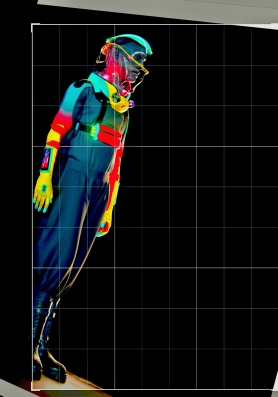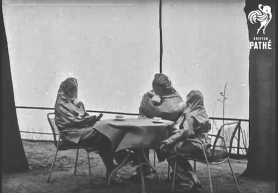…

Miguel Risueño’s Micrashell half-suit — on the top half of the mannequin — is on virtual (software) drafting boards, somewhere between a concept and prototype-in-progress. This is a Production Club image interpreted by pG
…
…
There has been a blizzard of reminders lately that crises can jump-start social transformations — can, for instance, do what World War I did for the Suffragettes with whom the women’s movement began. Right or wrong, here is pG’s prediction for the biggest technology-mediated change in our everyday existence to emerge from this pandemic seemingly set to rage on and on, now that scientists interviewed by The Verge, CNN and The Guardian are warning us that we may never get acceptably risky, or safe — or any — vaccines against Covid-19: Fighting this virus will bounce us to the long-expected next stage of the digital revolution — ‘body-borne’ or ‘wearable’ computing.
The Wikipedia credits the invention of computing attached to our bodies to a Canadian engineer, Steve Mann, in the late 1970s. We have already met some of its components, if we don’t own them, as smartwatches and fitness trackers. These could well be followed by a larger constituent, if not a whole garment — a ‘half-body’ suit called a Micrashell, now somewhere between a concept and a prototype dreamt up by a Spanish stage-designer in the entertainment business, Miguel Risueño. Search engines’ earliest record of its launch appears to be a post on 29 April on CDM.link ** — just four weeks after pG’s first post about a virus-shielding, one-piece, whole-body outfit tentatively named a flusuit.
Risueño is in charge of inventions at Production Club, which is a studio based in Los Angeles and Spain that specialises in creating ‘immersive experiences’ for the raver-clubber-gamer class in electronic music and dancing. Explosive interest in the Micrashell among other specialists in imagining and aesthetics is clear in the excitement in posts on scores of websites everywhere, including one on Architectural Digest India noting that the pandemic ‘has inspired artists and designers all over the world to create avant-garde Personal Protective Equipment (PPE) not only for frontline workers, but also for the general population.’
Risueño and his team say that they will first be selling their idea to businesses, not consumers, because the Micrashell’s yet-to-be-decided price tag will be high — like those of the first components of the internet and computer revolution, which were paid for by the U.S. military. The first buyers Production Club has in mind are concert organisers and promoters and other specialists in giant live events whose audiences have vanished in the lockdowns. Risueño envisages these companies renting his half-suits to concert-goers, and being responsible for sterilising them between rentals and events.
A childhood friend of pG who used to conduct experiments in telepathy with her younger brother, each stationed in a different room in their house, would end their tests hoping to create a record of segments of thoughts that they — on rare occasions — apparently succeeded in transmitting to each other. If telepathy had been scientifically confirmed as real, it might explain the following curious overlaps between the entries here about a pandemic-protective futuresuit and announcements by the Risueño dream factory:
GETTING PHYSICAL
Whereas most others speculating about how the pandemic will alter ordinary human life are focusing on virtual solutions — such as offices in the ether, and moving various branches of the performing arts online — the suit idea is about physical adaptation. Both pG and Production Club see it as a way to make social distancing more effective, but also of ending the suffering and harmful consequences of lockdowns, preserving familiar human connections and freedom of movement as far as possible.
ADDING COMPUTING TO CLOTHES
Both Production Club and pG — in the 1 April post here — have in different ways described garments with smartphone capabilities and high-tech sensors to monitor the suit-wearer’s environment and safety.
INCLUDING A RESPIRATORY SHIELD
Both the pG and Production Club envisionings equip a futuresuit with an N-95-grade respiratory mask, although p-G’s is replaceable and Production Club’s includes a sophisticated system of air filtration.
USING AESTHETICS AND COLOUR FOR ALLURE
The startling resemblance between the photograph of the suit used to announce the Micrashell (above) and the image in pG’s second post about an anti-Covid-19 suit — bright, vibrant colours against a black background — fit a shared recognition that aesthetic allure will make it more likely that young early adopters will want a futuresuit. Whereas pG pointed out that users would not necessarily have to look like astronauts and might be offered fitness-flaunting suits made of transparent materials, Risueño told NBC Los Angeles that his suit ‘is a little bit more of a fashion piece than something that looks like a medical device.’
There the similarities more or less end. Production Club’s version lacks pG’s disposable stick-on-strip-off double-gloves and soles for shoes, and suggestion of biodegradability as a bonus — but in all other respects, is a far more intricate and elaborate conception. It includes, for example, battery-powered sound and messaging systems described in detail in the comprehensive Globetrender report about it. It has provisions for eating and drinking by a suit-wearer, and anticipates that what goes in must eventually come out — the notorious loo-break nuisance of jumpsuits — which explains why it ends at the waist.
But a top-only half-suit like the Micrashell must inevitably sacrifice anti-virus protection to some degree and will surely have to be reconsidered. As thrilling as it is for the futurists among us, the Production Club prototype is bound to lose a few — probably, a lot — of its features to be manufacturable in the near future.
Something about Risueño is reminiscent of the spirit and pan-directional imagining of Steve Jobs — in conversations with him around 1980 — who emerged seemingly from nowhere to reorient the computer business for ordinary people. He paid unprecedented attention to elegant usability and fashion, giving these as much importance as technical minutiae in an era in which giant established computer-makers bored outsiders with jargon-laden droning about megaflops and ‘OEM’-marketing strategies (no, you really don’t want to know about those).
Miguel Risueño could be an imaginer too far ahead of his time, which is just as problematic as being a laggard (and in this respect too, would be a pG fellow-traveller). His name could be forgotten even six months from now. Or he — or someone very like him, from somewhere no one is expecting — could be the first of the new guard in the next transformation of computing.
..
** A fact-checking post-publication Google search on 29 May has turned up a Fast Company report on 27 April.


